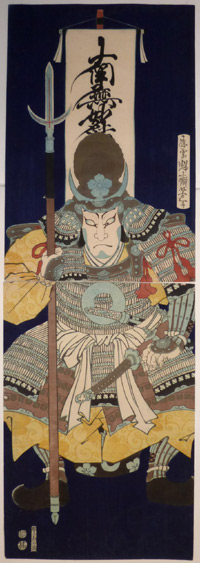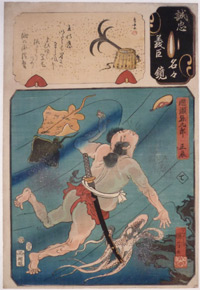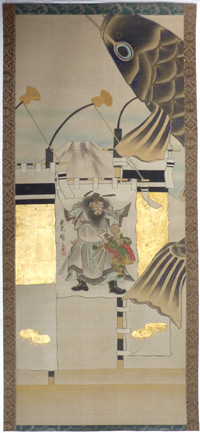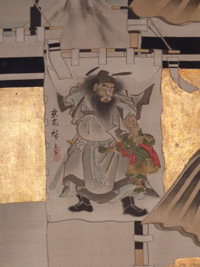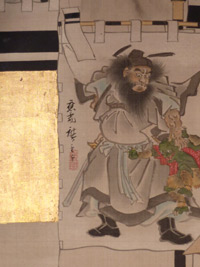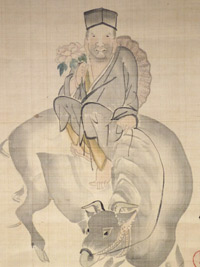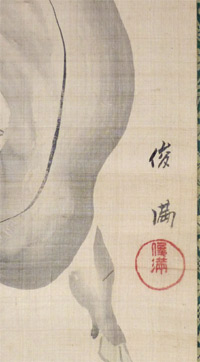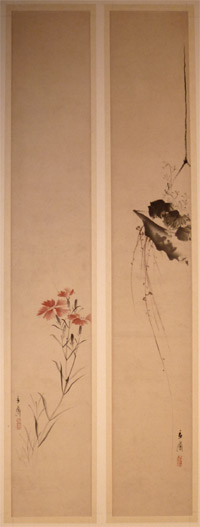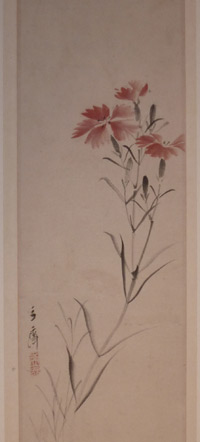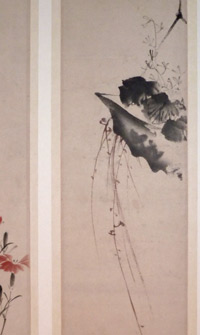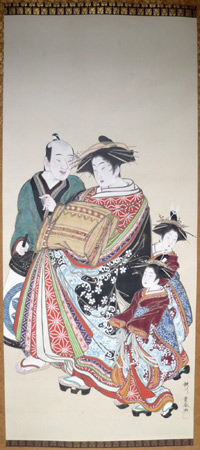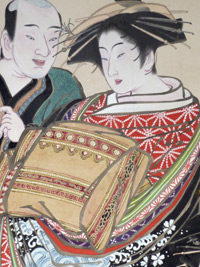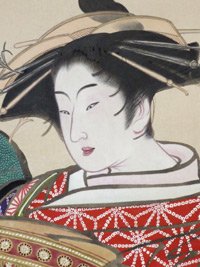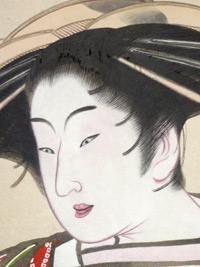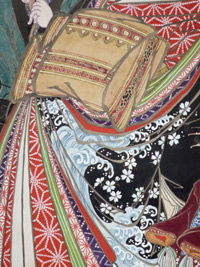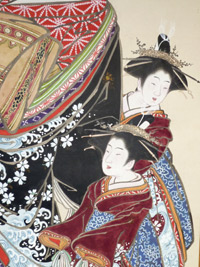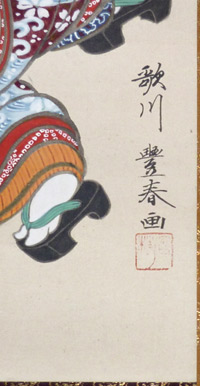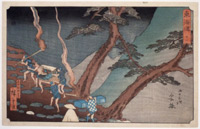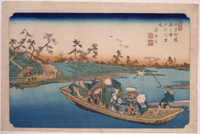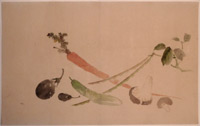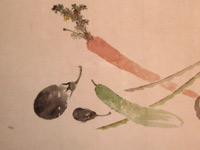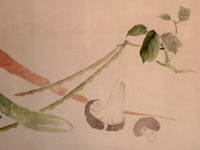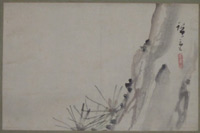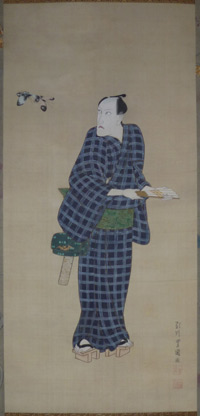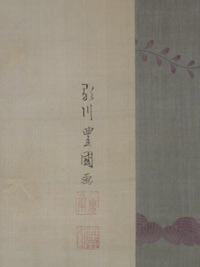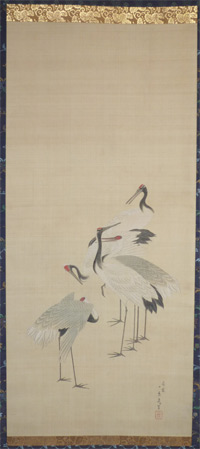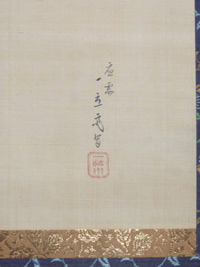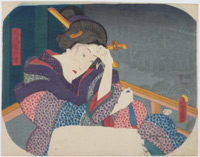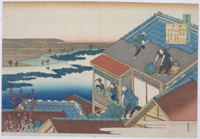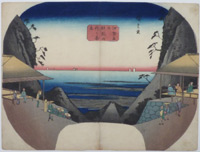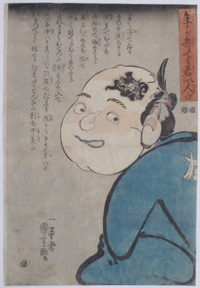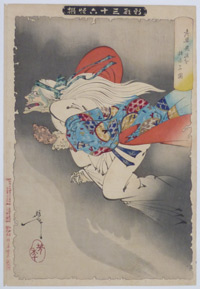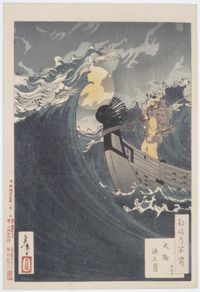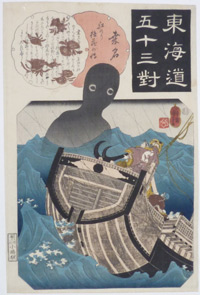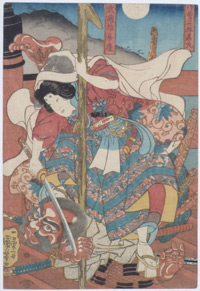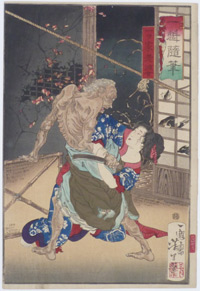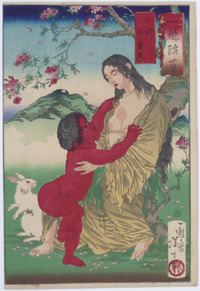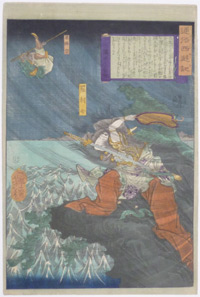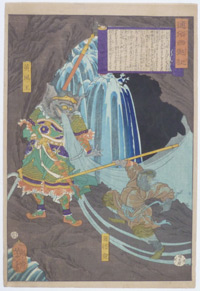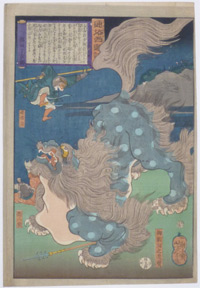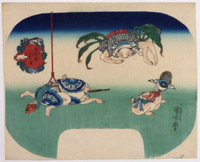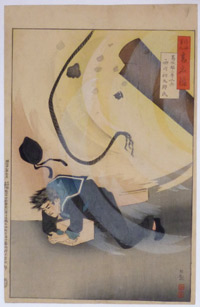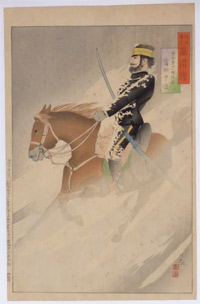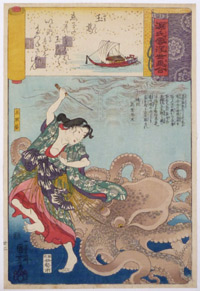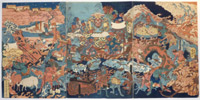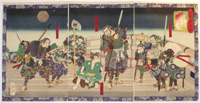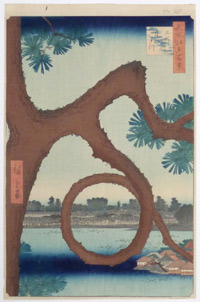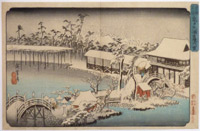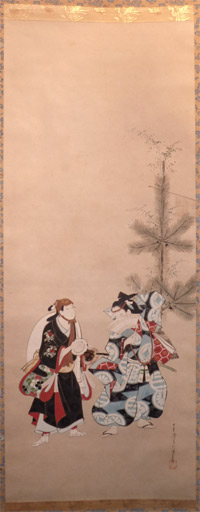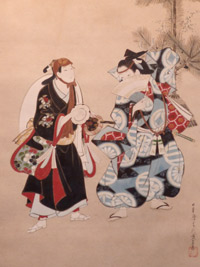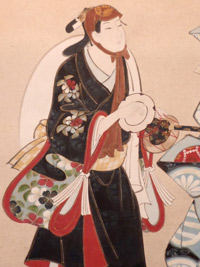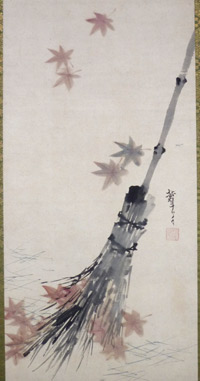/category/archive/page/31/
Tsukioka YOSHITOSHI (1839-1892)
Click here to view image full size.
A vertical diptych of Kato Kiyomasa ( 1562-1611 ). A famous general best known for his participation in the invasion of Korea. Shows him seated before his personal banner inscribed Nan myo no rengekyo, “Hail Lotus Sutra.” On his breast is his mon, a large ring. Published by Maruya Jimpachi, 1867. Rare.
Fine impression and colour. Slight offsetting of blue on banner, otherwise extremely good condition. Full size so that the two sheets fit perfectly. Signed Oju kaisai Yoshitoshi.
Status: Sold
Utagawa KUNIYOSHI (1797-1861)
Click here to view image full size.
The ronin Mase Magokuro Masatoki swimming to the surface surrounded by two rays and an octopus. His sword is loosely strapped around his waist. From a set Seichu gishin meimei kagami, “Mirror of the True Loyalty of the faithful Retainers, Individually.” Published by Iseya Isaburo, 1857. Robinson S90.41. A fine design.
Fine impression and colour. Extensive sprayed gofun ( oxidised ). Light discolouration top right, but otherwise good condition. Signed Ichiyusai Kuniyoshi ga.
Status: Sold
Tsukioka YOSHITOSHI (1839-1892)
Click here to view image full size.
Shows a scene during the siege of Nagashino Castle by Takeda Katsuyori. Torii Suneemon Katsutaka was sent to get help and managed to evade the guards. He insists on returning to his comrades but meanwhile Takeda had fastened bells to the cables on the castle’s exit which gave the alarm and frightens a flock of herons. Katsutaka was captured and died a samurai’s death shouting hold fast to his comrades. Takeda’s troops were subsequently massacred. Published by Kinseido, 1862. From a series Bidan musha hakkei, “Eight Views from Fine Tales of Warriors.”
Fine impression and colour. The rain burnished and the birds’ plumage gauffraged. Slight edge restoration, otherwise very good condition. Signed Tsukioka Yoshitoshi hitsu.
Status: Sold
Ichiryusai HIROSHIGE (1797-1858)
Click here to view image full size.
A fascinating specially commissioned painting by Hiroshige showing a large carp windsock ( koinoburi ) and Boys’ Day banners. Fuji is seen in the distance. The centre banner shows Shoki, the Demon Quellor, exorcising an oni. Shoki images were popular in houses to ward off evil during the Boys’ Day Festival, Tango no sekku, held on the 5th May. The carp was displayed outside homes of families with boys and their strength and character was symbolised by the determination of the carp swimming upstream. See also the print Suido-bashi, Surugadai from the Meisho Edo hyakkei, “One Hundred Famous Views of Edo,” published 1857 where Hiroshige uses the same large carp windsock. Sumi and full colour on silk. Extensive use of gold on the banners, the clouds below and the carp. The eye of the carp lacquered. 28.25 x 11.62 in x 72 x 29.5 cms. Original mount removed. The painting can either be framed and glazed or remounted. Very good condition. Signed Ojyu ( “commissioned” work ) Hiroshige fude. Seal Ichiryusai.
Status: Sold
Kubo SHUMMAN (1757-1820)
Click here to view image full size.
A fine painter and renowned for his surimono, and for supervising the design and carving of them for fellow poets. Produced some refined prints and contributed to kyoka anthologies. Changed the character with which he wrote “Shun” of Shunman from”Spring” to “Excel” in 1782. Shows a Botangesyohaku ( poet ) holding a peony and riding an ox. The kyoka poem above is by Ota Nampo ( 1749-1823 ), a leading light of popular literature who often collaborated with Shumman. Sumi and light colour on silk. 36 x 12 in; 91.5 x 30.5 cms. Old mount and box. In very good condition. Signed and sealed Shumman.
Status: Sold
Ichiryusai HIROSHIGE (1797-1858)
Click here to view image full size.
A pair of narrow paintings showing fringed pinks on one side and a hanging basket with ferns on the other. Sumi and colour on paper. 35.5 x 5.62 in; 90 x 14.2 cms each. Painted in semi-Shijo style. Fine condition. Framed and glazed. Signed Ryusai and sealed Ichiryusai on each.
Status: Sold
Utagawa TOYOHARU (1735-1814)
Click here to view image full size.
An extremely fine large painting by Toyoharu – the founder of the Utagawa School and teacher of Toyokuni and Toyohiro. Show a group comprising a high-ranking courtesan, her two kamuro ( attendants ), and her manservant carrying a lantern with either the crest of the Yoshiwara House or the crest of the courtesan. They are probably venturing out to meet wealthy customers in the teahouses of the Yoshiwara. The ample girth of the courtesan is typical of Toyoharu’s style at this time. Her surcoat ( uchikake ) is wonderfully decorated with breaking waves; the theme repeated on the coat of the front attendant. Little is known of his beginnings but it is thought he studied under the Kano-school master Tsuruzawa Tangei. He then went to Edo around 1763 where it is thought he was the pupil of Shigenaga and Sekien. Amongst his achievements was the development of the uki-e or perspective print. He gave up print design in the 1780s. Full colour on paper, 48.75 x 21.75 in; 124 x 55.5 cms. Fine new mount and double box. Perfect condition. Painted in his prime, c 1780. Although prolific ( something like 100 paintings are known by him ), this is probably the finest example extant.
Status: Sold
Ichiryusai HIROSHIGE (1797-1858)
Click here to view image full size.
Hakone from the “Reisho” Tokaido. So-called because of the titles written in formal script. The best Tokaido set after the Hoeido. Shows travellers holding pine-torches climbing a mountain path at night. The Hakone mountains were one of the most gruelling parts of the Tokaido, but at the same time one of the most relaxing with the hot springs, Lake Ashi and the fine cryptomeria trees. Published by Marusei, c 1851-2. One of the five best designs from the set and probably the masterpiece. The composition and use of kimetsubishi to show the woodgrain in the night sky and mountains makes it one of Hiroshige’s most beautiful prints.
Fine impression. Fine colour and condition. Signed Hiroshige ga.
Status: Sold
Keisai EISEN (1790-1848)
Click here to view image full size.
Warabi, one of the Stations from Kisokaido rokujukyutsugi no uchi, “Sixty-Nine Stations of the Kisokaido.” The set of seventy prints was started by Eisen and published by Hoeido in 1835, but in 1837 Hiroshige took over and completed the set with the publisher Iseya Rihei ( Kinjudo ). Warabi no eki Todagawa watashi, “Warabi Station, Ferry on the Toda River.” Shows a ferry with a group of travellers: a pair of goze ( blind singers ); three males with hats; a horse and handler, and a porter smoking in the prow. The Station is seen on the far shore.
Very fine impression of the first edition with signature. Fine colour and condition. Signed Eisen ga.
Status: Sold
Katsushika HOKUSAI (1760-1849)
Click here to view image full size.
A wonderfully delicate study using light washes showing a Japanese carrot, mushrooms, a Japanese cucumber ( which have knobbles or spikes as opposed to our smooth-skinned varieties ), aubergines and long beans ( possibly yardlong beans ). Obviously from a large album of such studies ( it has a light centre fold ) which would have been signed and/or sealed at the end.
Full colour on paper. Fine condition. 11.5 x 18.5 in; 29.5 x 47 cms.
Status: Sold
Katsushika HOKUGA (active 1804-1818)
Click here to view image full size.
A painting of a bamboo whisk seller. Hokuga was a pupil of Hokusai. A vigorous painting. Sumi and light colour on paper. 10.75 x 14 in; 27.5 x 35.5 cms. Nicely mounted and in fine condition. New box. Signed and sealed Hokuga.
Status: Sold
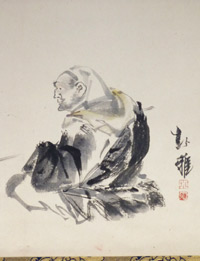
Click here to view image full size.
Utagawa HIROSHIGE (1797-1858)
Click here to view image full size.
A small drawing taken from an album of an old pine tree. Sumi and light colour on paper. Image size, 23.25 x 11 inches; 59 x 28 cms. Mounted as a painting. Very good condition. Signed Hiroshige.
Status: Sold
Utagawa TOYOKUNI I (1769-1825)
Click here to view image full size.
An important painting: Nanadaime Danjuro sugata-e, “Portrait of Danjuro VII.” Painted at the end of the Bunka period ( c. 1815 ), it shows the young Danjuro after his succession. He wears the Danjuro mimasugoshi, Danjuro’s triple-plaid kimono pattern. His favourite tobacco pouch with the bat-shaped catch is hanging at his waist. He is looking at two butterflies. An allusion to the famous story of Zhuang Zhou who dreams of being a butterfly, only to wake and wonder if he is, in fact, not a butterfly dreaming of being Zhuang Zhou. The story symbolizing the evanescence of life. A similar painting of Nakamura Utaemon II dated 1812 is in the Museum of Fine Arts, Boston, acc. No. 11.7864. Full colour on silk. Image size 23.25 x 11 inches; 59 x 28 cms. Two repaired wormholes not affecting image, otherwise very good condition. Interesting old embroidered and hand-painted mount. Signed Utagawa Toyokuni ga with seals Ichiyosai and Toyokuni.
Status: Sold
Utagawa HIROSHIGE (1797-1858)
Click here to view image full size.
A fine and rare painting: Gunkaku zu, “A Flock of Cranes.” Hiroshige designed many fine kachoga during the 1830s through to the 1850s but there exist few paintings. This was a commissioned work from Hiroshige. The tancho ( “red crest” ) Japanese Crane, Grus japonensis, is the second rarest crane in the world, migrating to East Asia in the fall to spend the winter. There is also a resident flock in Hokkaido. Much loved by the Japanese, the crane was a symbol of luck, longevity and fidelity. Full colour on silk, image size 34.5 x 15.75 inches; 88 x 40 cms. In perfect condition with a futo-maki ( thick wooden roll to preserve the painting from damage ). New box. Signed Ojyu ( “commissioned” work ) Ichiryusai hitsu. ( A rare form of the signature used c. Tenpo 10 to 11 [ around 1839 – 40 ]. ) The Ichiryusai seal is also a rare form used around mid Tenpo period.
Status: Sold
Utagawa KUNISADA (1786-1864)
Click here to view image full size.
An uncut fan print with title: Furyu yami no kaori, “A Refined Date in the Dark.” Shows a beauty holding a pipe and contemplating a dusky garden and her hidden lover. From a set published by Kojimaya Jubei, with date seal 3/1852.
Fine impression and colour. Small paper fibre on woman’s cheek, otherwise fine condition. Signed Konomi ni ujite ( “With my taste” ) Toyokuni ga.
Status: Sold
Katsushika HOKUSAI (1760-1849)
Click here to view image full size.
A poem by the Lady of Ise which speaks of a love that has not been reciprocated. From Hyakunin isshu uba ga etoki, the “Hundred Poems Explained by the Wet Nurse.” Published by Eijudo and Iseri, c.1835-6. Although obviously intended to be a set of 100 prints, only 27 are known plus drawings for others. The scene shows two ladies looking out over the rice fields to the Naniwa Inlet ( the ancient name for the region around Osaka ). The house is either being built or repaired with new tiles to the roof.
Exceptionally early impression with beautiful printing. This appears to be the earliest state with gradation on the roof bottom right and down from the top. Fine colour. Full size. Very slight centre fold, otherwise very good condition. Signed Zen Hokusai manji.
Status: Sold
Ichiryusai HIROSHIGE (1797-1858)
Click here to view image full size.
An uncut fan print from a set of views in Ise: Ise meisho, Asakumayama toge no chamise, “Teahouses on the Mount Asakuma Pass, Famous Places of Ise Province.” Hiroshige used this view about a decade later for his oban tata-e set The 60-Odd Provinces. He cleverly uses the cliff sides to wrap around the uchiwa-e shape. Published c. 1840. Extremely rare. This actual impression illustrated in Hiroshige no uchiwa-e, Unsodo 2010, p. 78, pl. 108. Ex collection Maroni, seal at bottom.
Fine impression and colour. Centre fold, as often, otherwise very good condition. Signed Hiroshige ga.
Status: Sold
Tsukioka YOSHITOSHI (1839-1892)
Click here to view image full size.
Roba kiwan o mochisaru zu from Shinkei sanjurokkaisen, “New Forms of Thirty-six Ghosts.” The best design from the set published by Sasaki Toyokichi, 1889. This famous story recounts how Watanabe no Tsuna cuts off the arm of the demon Ibaraki at the Rashomon Gate, Kyoto in 976. He secretes the arm away in a box. Subsequently he is visited by his wet-nurse ( or aunt – depending on which version you read ) who convinces him to show it to her. Instantly she snatches the arm and flies off revealing herself to be Ibaraki in disguise. The story became the famous no play Ibaraki. Ex John Stevenson collection.
Fine impression and colour. The first edition. Slight edge crease on left border, otherwise very good condition. Signed Yoshitoshi.
Status: Sold
Tsukioka YOSHITOSHI (1839-1892)
Click here to view image full size.
The best design from the set Tsuki hyakushi, the “Hundred Phases of the Moon”. The set published between 1885 and 1892 ( this being 1886 ) by Akiyama Buemon. Benkei against a full moon. In 1185 Yoshitsune attacked by his half-brother Minamoto no Yoritomo, was forced to flee to northern Japan by ship. Sailing along the Inland Sea off the coast of Harima Province not far from Kyoto, the ship was struck by a storm in Daimotsu Bay caused by the vengeful ghosts of the Taira warriors Yoshitsune and his men had slain. Benkei pacified the spirits in the prow of the boat.
Fine impression, colour and condition. An impression that has not been in an album: Full margins with very extensive mica. Signed Yoshitoshi.
Status: Sold
Ichiyusai KUNIYOSHI (1797-1861)
Click here to view image full size.
The apparition of the Sea Monk, Umibozu, looming above the sailor Kawanaya Tokuzo. The best design from Tokaido gojusan tsui, Station 41, Kuwana. The legend has it that Tokuzo, against the advice of his peers, went to sea on the last day of the year. He subsequently experienced huge seas and the monster who demanded to know what was the most horrible thing he knew. He replied that his profession was the most horrid. Satisfied, the creature descended into the Stygian gloom and the storm abated. Published by Kojima-ya Jubei, c. 1845. Illustrated in Robinson, Kuniyoshi, HMSO, 1961, no. 49.
Fine, early impression with the light blue on the sea. Fine colour. Expert remargin at bottom but retaining black border. Signed Ichiyusai Kuniyoshi ga.
Status: Sold
Ichiyusai KUNIYOSHI (1797-1861)
Click here to view image full size.
Musashi-bo Benkei overcome by Onzoshi Ushiwaka Maru on Gojo Bridge under a full moon. Benkei was enormously tall and strong and had defeated many challengers on the bridge in Kyoto. However, he met his denouement in Yoshitsune who, although much smaller, was a fencing master. He is shown holding Benkei down with his geta, sword and large stave. From a rare set published by Tsuta-ya Kichizo, c. 1843. Robinson S1f 3.
Very good impression and colour. Slight trimming all round, otherwise very good condition. Signed Ichiyusai Kuniyoshi ga.
Status: Sold
Ichiyusai KUNIYOSHI (1797-1861)
Click here to view image full size.
A triptych showing the Soga Brothers’ last stand in the rain on Suso Moor under Mount Fuji. Fuji no Suso-no Soga kyodai hommo wo togeru zue. Published by Yamaguchi-ya Tobei, c. 1845. A subject covered by many artists. Illustrated in Robinson, Kuniyoshi, HMSO, 1961, no. 44.
Very good impression and colour. Slightly trimmed at bottom, otherwise very good condition. Signed Ichiyusai Kuniyoshi ga.
Status: Sold
Tsukioka YOSHITOSHI (1839-1892)
Click here to view image full size.
The old hag of the Lonely House. A gruesome subject: The evil witch is intent on cutting open the pregnant woman’s belly to get at the unborn child whose blood she needs for a magic potion. From Ikkai zuihitsu, “Essays by Yoshitoshi.” A set of 13 prints published by Masadaya in 1872. There are numerous variations in seals in this fine set but, as yet, no research has been done into their significance.
Very fine impression and colour. Trimmed close on the left but retaining black border. Retains original album backing. Signed Ikkaisai Yoshitoshi hitsu.
Status: Sold
Tsukioka YOSHITOSHI (1839-1892)
Click here to view image full size.
Yamauba and Kaidomaru from Ikkai zuihitsu, “Essays by Yoshitoshi.” A set of 13 prints published by Masadaya in 1872 ( this design being 1873 ). Shows the mother and son ( also known as Kintaro ). He of the enormous strength is often shown acting as umpire at a wrestling match between a hare and a monkey. The Madonna-like figure here is one of the few Yoshitoshi designs to borrow heavily from western art. There are numerous variations in seals in this fine set but, as yet, no research has been done into their significance.
Very fine impression and colour. There is an alternate version of this print with Kintaro printed in a light brown. Trimmed close on the left but retaining black border. Retains original album backing. Signed Ikkaisai Yoshitoshi hitsu.
Status: Sold
Tsukioka YOSHITOSHI (1839-1892)
Click here to view image full size.
The monkey of phenomenal powers Sun Wukong battles Kinkaku Daio on a sea cliff. From a fine, rare and early set of at least 21 designs: Tsuzoku saiyuki, “Journey to the West” published by Fukuta between 10/1864 and 8/1865, this being 12/1864. The story covers the journey of Son Goku ( Chin. Sun Wukong ) a.k.a. The Monkey King to India, accompanying Xuanzang, to retrieve the Buddhist sutras. Sun Wukong, born from a stone, had supernatural powers; possessed enormous strength; could transform himself into other people and objects, and cover large distances in a single flip. The story covers 100 chapters and there are a multitude of characters and events. A fine design.
Fine impression. Minimal soil and fading. Signed Ikkaisai Yoshitoshi hitsu.
Status: Sold
Tsukioka YOSHITOSHI (1839-1892)
Click here to view image full size.
The monkey of phenomenal powers Sun Wukong battles a warrior ( Rakijo ? ) on a precipitous cliff over a choppy sea. From a fine, rare and early set of at least 21 designs: Tsuzoku saiyuki, “Journey to the West” published by Fukuta between 10/1864 and 8/1865, this being 12/1864. The story covers the journey of Son Goku ( Chin. Sun Wukong ) a.k.a. The Monkey King to India, accompanying Xuanzang, to retrieve the Buddhist sutras. Sun Wukong, born from a stone, had supernatural powers; possessed enormous strength; could transform himself into other people and objects, and cover large distances in a single flip. The story covers 100 chapters and there are a multitude of characters and events. A fine design.
Fine impression. Minimal soil and fading. Signed Ikkaisai Yoshitoshi hitsu.
Status: Sold
Tsukioka YOSHITOSHI (1839-1892)
Click here to view image full size.
The monkey of phenomenal powers Sun Wukong battles Kofuo, the wind demon who had captured Genjosanzo. From a fine, rare and early set of at least 21 designs: Tsuzoku saiyuki, “Journey to the West” published by Fukuta between 10/1864 and 8/1865, this being 12/1864. The story covers the journey of Son Goku ( Chin. Sun Wukong ) a.k.a. The Monkey King to India, accompanying Xuanzang, to retrieve the Buddhist sutras. Sun Wukong, born from a stone, had supernatural powers; possessed enormous strength; could transform himself into other people and objects, and cover large distances in a single flip. The story covers 100 chapters and there are a multitude of characters and events. A fine design.
Fine impression. Minimal soil and fading. Signed Ikkaisai Yoshitoshi hitsu.
Status: Sold
Tsukioka YOSHITOSHI (1839-1892)
Click here to view image full size.
The monkey of phenomenal powers Sun Wukong battles an enormous polka dot shishi lion. Shidado no roma. From a fine, rare and early set of at least 21 designs: Tsuzoku saiyuki, “Journey to the West” published by Fukuta between 10/1864 and 8/1865, this being 12/1864. The story covers the journey of Son Goku ( Chin. Sun Wukong ) a.k.a. The Monkey King to India, accompanying Xuanzang, to retrieve the Buddhist sutras. Sun Wukong, born from a stone, had supernatural powers; possessed enormous strength; could transform himself into other people and objects, and cover large distances in a single flip. The story covers 100 chapters and there are a multitude of characters and events. A fine design.
Fine impression. Minimal soil and fading. Signed Ikkaisai Yoshitoshi hitsu.
Status: Sold
Ichiyusai KUNIYOSHI (1797-1861)
Click here to view image full size.
An uncut fan print of the utmost rarity with title E-kyodai awase kagami. An impossible title to translate but something like Disparate Images as Opposing Mirrors. Another from this set is illustrated in Juzo Suzuki, Kuniyoshi, 1992, pls. 421 and 422 ( from Merlin Dailey collection and also illustrated in Exhibition Of Ukiyo-e By Kuniyoshi, Riccar Art Museum, 1978, pls. 254 and 255, and elsewhere ). And another two designs are illustrated in the new Nikkei/Mori Arts Center Kuniyoshi catalogue, nos 321 and 322. These humorous prints show figures in contorted positions which, when seen in silhouette, reveal themselves as animals, crustaceans or fish. Two prints were published: as here, and the silhouette which was stuck on the reverse of the fan. The figures on this print become, in silhouette, a crab, a tortoise, and a Tosakin goldfish. I have been unable to locate another illustrated impression of this print and it may well be the only known example. Published c. late 1840’s probably by Ibaya Sensaburo as the other design from this set has this publisher’s seal.
Very fine impression, colour and condition. Mint. Signed Ichiyusai Kuniyoshi giga.
Status: Sold
Kobayashi KIYOCHIKA (1847-1915)
Click here to view image full size.
Shows ordinary seaman Nishikawa Hatsutaro of the corvette Katsuragi which saw action during the Sino-Japanese war ( 1/7/1894-17/4/1895 ). He appears to be saving something by covering it with his body. From a set Rikukaigunjin komei kagami, “Mirror of Army and Navy Heroes.” Published by Inoue Kichijiro, 2/1895. For whatever reason, a rare set. Fine design.
Fine impression and colour. Signs of mounting au verso, otherwise fine condition. Signed Kiyochika.
Status: Sold
Kobayashi KIYOCHIKA (1847-1915)
Click here to view image full size.
Shows Lieutenant Colonel Tomioka Sanzo charging on horseback. He was the commander of the 22nd infantry regiment during the Sino-Japanese war ( 1/7/1894-17/4/1895 ). From a set Rikukaigunjin komei kagami, “Mirror of Army and Navy Heroes.” Published by Inoue Kichijiro, 2/1895. For whatever reason, a rare set. Fine design.
Fine impression and colour. Signs of mounting au verso, otherwise fine condition. Signed Kiyochika.
Status: Sold
Ichiyusai KUNIYOSHI (1797-1861)
Click here to view image full size.
The best design from Genji kumo ukiyoe awase, “Ukiyoe Comparisons of the Cloudy Chapters of Genji.” A set comparing famous warriors to the Chapters of the Genji Monogotari ( Tale of Genji ) written by Lady Murasaki Shikibu ( c 973 – 1025 ). This design is for Chapter 22, Tamakatzura. Shows the pearl diver, Tamatori-hime, who has reclaimed the precious pearl stolen by the Dragon King. She is pursued by a host of his aquatic retainers including a giant octopus before finally returning the jewel to her husband Fujiwara no Kamatari, albeit buried in her chest for safety and causing her death. A popular subject with Kuniyoshi who designed a number of other oban prints and triptychs on the subject. The Dragon King’s palace can be seen beneath the waves in the background. Published by Iseya Ichibei, 1843-5.
Very good impression, colour and condition. Each sheet lightly attached. Signed Ichiyusai Kuniyoshi ga.
Status: Sold
Ichiyusai KUNIYOSHI (1797-1861)
Click here to view image full size.
A vision of hell. In the centre sits Enma, King of Hell, dressed as a Chinese official flanked by minions. He sits in judgement deciding whether a deceased person had been good or bad. Those found wanting are subjected to horrendous tortures, miscreants being boiled, crushed, burnt or having their tongues pulled out. Mothers in Japan were known to threaten naughty children with a visit from Enma. Kuniyoshi is known to have owned a “hell” garment which he had painted and is often pictured wearing it. Published by Tsutaya Kichizo c. mid 1830’s. Rare. Another example illustrated in the new Nikkei/Mori Arts Center Kuniyoshi catalogue, no 111.
Very good impression, colour and condition. Each sheet lightly attached. Signed Ichiyusai Kuniyoshi ga.
Status: Sold
Tsukioka YOSHITOSHI (1839-1892)
Click here to view image full size.
A rare triptych Toyotomi shoshinroku, “A Record of the Advancement of Toyotomi Hideyoshi.” Shows the young Hideyoshi ( 1537 – 1598 ) demanding an apology from Hachisuka Koroku on Yahagi Bridge. Published c. 1869 by Yorozumago.
Fine impression and colour. Gauffrage and extensive burnishing. The paulownia border intact which is often trimmed. Signed Ikkaisai Yoshitoshi hitsu.
Status: Sold
Utagawa KUNISADA (1786-1865)
Click here to view image full size.
An apparently unrecorded horizontal diptych, each panel measuring 6.5 x 15 in; 16.5 x 38 cms. Two groups meet in a snowy landscape and the children, boys on left and girls on right, start a snowball battle. An early surimono-style design, published c 1826-7. Publisher unread ( Kagaya Kichibei ? ) A beautiful rarity.
Fine impression. Extremely good colour. Slight vertical folds, otherwise very good condition. Untrimmed, with ample space for joining. Signed Kunisada ga.
Status: Sold
Ichiryusai HIROSHIGE (1797-1858)
Click here to view image full size.
The Moon Pine, Ueno, Ueno sannai tsuki no matsu from Edo meisho hyakkei, “The Hundred Famous Views of Edo.” Published by Uoya Eikichi between Ansei 3 and 5 ( 1856 – 58 ), this design being Snake 8 ( 1857 ). Shows Shinobazu Pond, Ueno Park, seen through the ancient pine tree. ( also called the Rope Pine ).
Fine impression of the first edition. Trimmed close and slight fading. Signed Hiroshige ga.
Status: Sold
Ichiryusai HIROSHIGE (1797-1858)
Click here to view image full size.
The Kameido Shrine in snow. The best design from a Toto Meisho set of 21 prints published by Kikakudo ( Sanoki ) c. 1832-5 and then extended to 55 in c. 1839-42. The view shows the famous Drum Bridge, koi ponds and wisteria. The main shrine to the memory of Sugawara no Michizane ( Tenjin ), the father of Japanese learning, and built in 1662.
Fine impression. Probably the first edition with the cloak ( right figure ) and trousers ( left figure ) double printed, red over blue; crisp seal and red publisher’s seal in right margin ( later editions having the black seal of Sanoki ). These later editions have a black sky and a block defect appears at the edge of the pond centre left. Slight centre fold and shaved top right border, otherwise very good condition. Signed Hiroshige ga.
Status: Sold
Miyagawa CHOSHUN (1682-1752)
Click here to view image full size.
The pre-eminent painter of the first half of the eighteenth century but not better known because neither he or his pupils are known to have designed any prints. His subjects were invariably beautiful girls and women, which makes this painting especially interesting. Shows two new year manzai dancers. These performers would go from house to house in the new year dancing, singing and engaging in knock about routines. The left figure sings and plays a small drum while his companion holds a fan and dances to the beat. Behind, a typical new year pine tree decoration. Full colour on paper, image size 38.25 x 15.25 in; 97 x 38.75 cms. The costumes are exquisitely detailed with outlines in gold. In very good condition with new mount, old lacquer jiku and old box. Signed Nihon-e Miyagawa Choshun hitsu and with blurred seal but reading Choshun no in. Kyoho – Kampo eras. One of the masterpieces of the British Museum’s Ukiyo-e painting collection is a pair of Choshun handscrolls.
Status: Sold
Katsushika HOKUSAI (1760-1849)
Click here to view image full size.
A newly discovered Hokusai painting showing falling maple leaves, pine needles and a rustic broom. Pine needles and a broom would suggest the Pine Trees of Takasago. Uba’s broom sweeping away evil – bringing good luck. But the painting suggests a Zen theme, the previous mount being in the Rinpo style for the Japanese tea ceremony. The painting is from his Taito period ( 1808 – 1820 ) when he was in his mid 50’s. Sumi and red on paper. Image size 11 x 39.5 in; 28 x 100.5 cms. In very good condition, remounted using fine Kano-style brocade and a futo-maki. New box. Signed Taito hitsu with Fumoto no sato seal, “Village at the foot of the mountain.” This seal is known to be associated with his Taito period and is on around six paintings. No Japanese artist was plagiarized to the extent that Hokusai was. Inumerable drawings, paintings and prints purporting to be by him are in circulation.
Status: Sold
